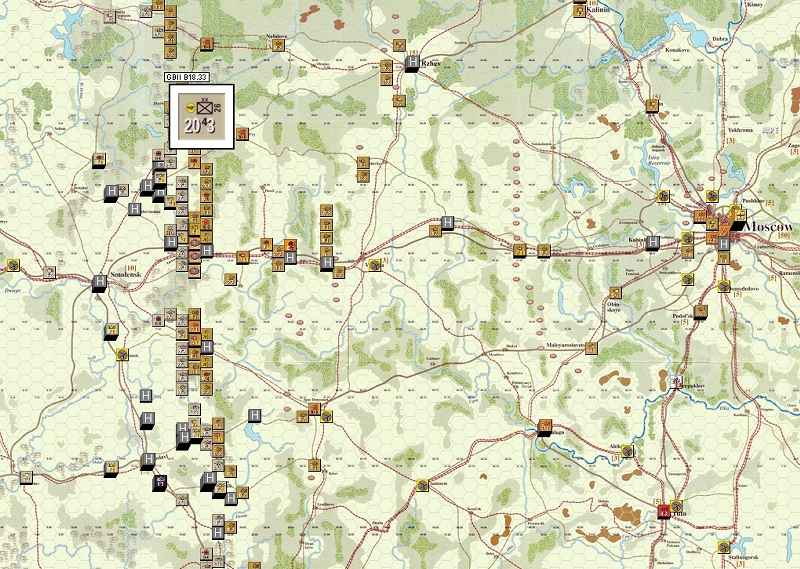(most of the links scattered around this post are images, because I like the aesthetic of the monster wargames, many of these come from boardgamegeek, but that I’ve mirrored here because the links get constantly changed/broken)
I was reading an article about simulators and wargames on RPS and the mention of “Panzer Battles: Battles of North Africa” got my attention. I’ve looked before into John Tiller’s games, but usually on the higher scale, larger breath of the “Panzer Campaigns” series.
I’m always intrigued by impossible games whose ambition transcends common sense, those human endeavors that motivate some people to go beyond. And while I’m not really a “player” of these things, I keep being fascinated by them and spending lots of time digging information, reading rules and whatnot. In the past I’ve “compared” a game like War in the East, a computer game, and Case Blue and other OCS games, for classic tabletop experience (all rules are usually available for free officially as .pdf files, and the games themselves can be played with also free Vassal modules, if one wants to fiddle directly with them). So once in a while something catches my attention and sends me on another round. For example CMANO, the modern “Harpoon”. But this is not the time to talk about it.
Last time I looked into Panzer Campaigns I was awed by this. Even if not clearly visible, those are all hexes, and that twisty line made by darker dots shows the actual counters. Those pieces you are supposed to move individually every turn… The scale and the detail are staggering, and they dwarf monster games like War in the East.
At the time I wrote down this silly comparison (and looking into it I also found mention of another of these monster games but of a different kind, Starfleet Battles):
Some stats?
Moscow ’42:
244,620 hexes
8,000/9,000 counters total
1 turn = 2 hours
Biggest campaign is 544 turns longversus War in the East:
26,000 hexes
4.000 counters
1 turn = 1 week
Biggest campaign is 224 turns long
The bottom line of all this is that, these days, something like Hearts of Iron IV doesn’t even get a passing glance from me, it’s like what’s Skyrim for RPGs.
But that’s just me because it looks like these mad experiments and extremely complex rules are on the way out, so we are looking at something that maybe will never be matched again. It’s like some treasure that soon might be completely forgotten…
This time the RPS article sent me looking at the Panzer Battles, instead. And in particular to Battles of Normandy. This is less of a monster game like Moscow ’42 because it doesn’t have a super huge campaign. It’s more like a collection of scenarios across smaller maps. But this didn’t stop them to outreach in a few areas…
This is the big map (source, it’s a png almost 200Mb big)
You can’t really see the hexes there, the map is 398,000 hexes, almost twice the map of Moscow ’42. Sadly I don’t think it’s playable as there’s no campaign that follows the whole thing and the two bigger scenarios seem still to use only smaller sections of that map. But if you are looking at D-Day then you want to play “the longest day”, the first day of the landings, and that’s one of the scenarios.
(open in a new window for a slightly bigger version)
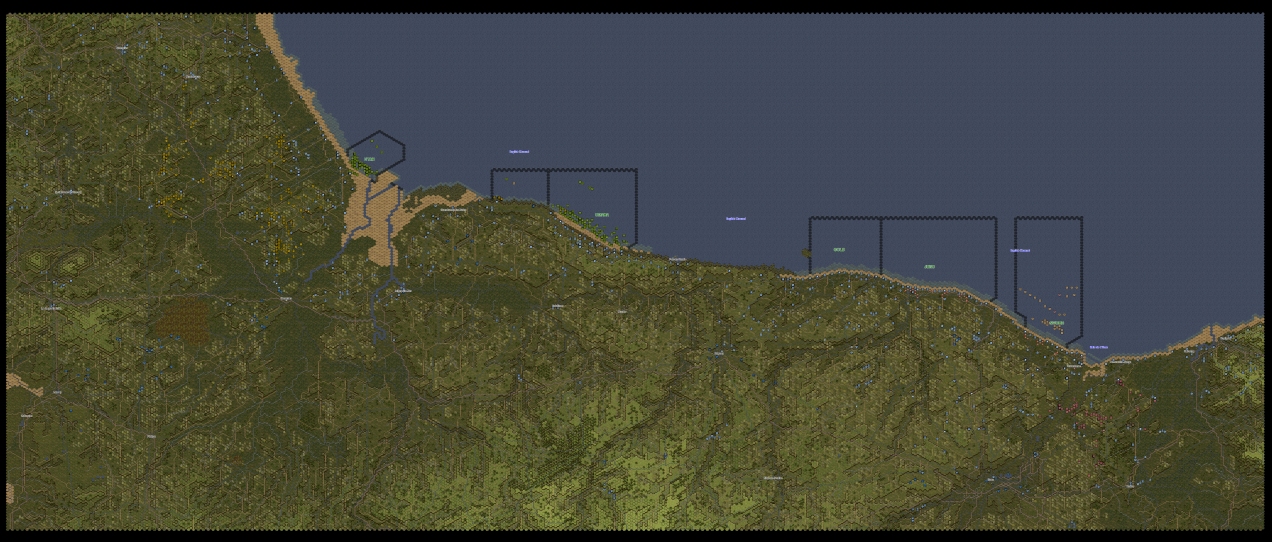
If you compare this with the image above you can see it’s only like 1/7 of the whole map, yet it’s still HUGE. This is a few turns into the scenario, in the morning when a few landings are already happening on Utah and Omaha, as you can see by the vague green blobs on those two beaches. Then there are also some faint light blue dots scattered around the whole map, those represent the Nazi troops defending the territory, and if you squint some more, on the left side of the map in particular, you could also spot some yellow dots (they blend with the green map), and those are again the allied forces, but that didn’t land like the others because they were parachuted there during the night and previous turns. It was quite beautiful to set the AI controlling both sides and just watch it happen.
This huge scenario is 40 turns long, and covers just one single day. During the night you get 1 turn every hour, then in the morning it gets broken down with one turn every half an hour.
All this ended up making me check another two games, both covering the same overall scenario, but this time not as computer games but as monster tabletop wargames. Both are again available on Vassal with free .pdf rules on their sites (links below).
The first is Atlantic Wall and that I already knew as one of those impossibly huge monster games.
The info page mentions one grand campaign made of 234 turns. This is the whole thing, it covers two months and a half. So with a quick calculation it’s three turns a day, two during the day and one for the night (confirmed by the rules).
The map is freaking huge, of course (here for more). On Vassal the whole thing zoomed out looks like this, or a closer look. (and a description of a game being played)
It seems to greatly surpass in detail one of the previous games in the same breadth (but here it looks impressive too, probably because it was scanned and printed in a bigger format). In fact that one had one turn covering a whole day. It is interesting how you can “slice” these historical situations in various ways, depending on what’s the focus. Of course the more you zoom in, adding detail, the more you lose the big picture, so you have that scenario from the computer game that gives 40 turns for just one day, then Atlantic Wall that covers almost three months, but that doesn’t go deeper than three turns a day… and this leads us to the third one, that bridges the two.
I found it by looking at a forum post, written by the designer of this other game while he was still developing it:
my game and Joe’s are of different scope. You can fit all of my four maps on one of Joe’s maps in Atlantic Wall. The distance from Sword to Caen in Joe’s game is 12 hexes or so. It’s 40 hexes or so in my game.
Mine is just on the Commonwealth Beaches and covers just the first week. Joe’s covers the entire Normandy campaign. Which you prefer depends on what you like. I happen to think the first week is very mobile and tense, and the remainder of the campaign is pretty static… so it’s not for me to play or design. Joe’s offers the completeness of the entire theater – and I know that is great for many gamers.
I actually already knew this guy because he also designed The Devil’s Cauldron and Where the Eagles Dare. These also being monster wargames but of the kind still kept on a level (somewhat) manageable. The fun thing of these two is that they can be JOINED into one bigger campaign that covers the whole thing across both games.
See this. Here’s The Devil’s Cauldron. It’s pretty big, right? And here’s Where the Eagles Dare, and that’s again huge. But then we have to JOIN them. Here’s from an angle, and here’s from the opposite. Even on the Vassal module the two can be joined, but the maps are kept separate because of the odd tiling, so I cut it up and joined it all together in a picture just to show the whole thing without the perspective.
These two games, combined, simulate Operation Market Garden (this operation is also covered in one of the modules for the computer game “Command Ops 2”, but I’ll make that comparison at another time). So let’s see this other game, by the same designer, but done to reproduce D-Day. It’s titled “The Greatest Day”, and the subtitle explains it all better: “Sword, Juno, and Gold Beaches, Battle for Normandy: Volume One”. This is just the eastern side of the landings, and once again it’s ultimately meant to be joined with another TWO games, all three together representing the whole front. But this one was released in 2015 and I found no mention at all the the other two games are actually being developed, so it’s possible they’ll never be made and the whole thing will remain a crazy dream.
It’s interesting to compare this one with the other two because it creates a sort of bridge between them. The computer scenario from the first game covered in detail just the first day, through 40 turns (but being a computer game it doesn’t have the intricacy and explicit complexity of the boardgames). Atlantic Wall instead is the 234 turn monster campaign, covering the whole thing from early June to 22 August. And to keep it playable they shrank the detail to 3 turns for a single day and a map that while being huge is still more zoomed out. And here we have The Greatest Day that covers the first week, with a day divided into 8 turns, two hours each, and then one single turn for the night, so 9 turns for a complete day.
(Rules for The Devil’s Cauldron, Where Eagles Dare and The Greatest Day are available here, all three part of the Grand Tactical Series. The vassal modules are here and here)
(Rules for Atlantic Wall are available here (under GOSS), and the Vassal module is here, but even if free you have to register. A current direct link is likely to stop working whenever they update it. This version also has the scenarios set up and is supposed to fix bugs, but it loads many times slower than the previous and has blurry counters for some reason…)
While it’s just 1/3 of the whole, it’s once again a monster game (complete). The full campaign goes from the night of 5 June, to 21:00 of 13 June. That should be 73 turns total. The designer says it’s not a small feat to play it all (the estimation is 20 hours for the single-day campaign, and 150 hours for the whole thing). On the surface the map of operation Market Garden looks way bigger despite the developer claiming this being twice as big, but I suppose The Greatest Day has a much higher counters density. That Market Garden campaign went from 15:00 of 17 September to the night turn of 24 September. The total is 60 turns, because this game has one less turn for each day, making the single night turn two hours longer and removing the 19:00 day turn.
A quick comparison on the surface:
– Atlantic Wall
2.5 months full theater campaign, 234 turns total, 3 turns/day.
– The Greatest Day
8 days campaign, only eastern landings, 73 turns total, 9 turns/day.
– The Longest Day scenario in “Battles in Normandy”
1 day campaign, all the landings, 40 turns total, 40 turns/day.
Looking closer at the map representations I can deduce that, roughly, every step reduces the size of one hex by half:
(Atlantic Wall)
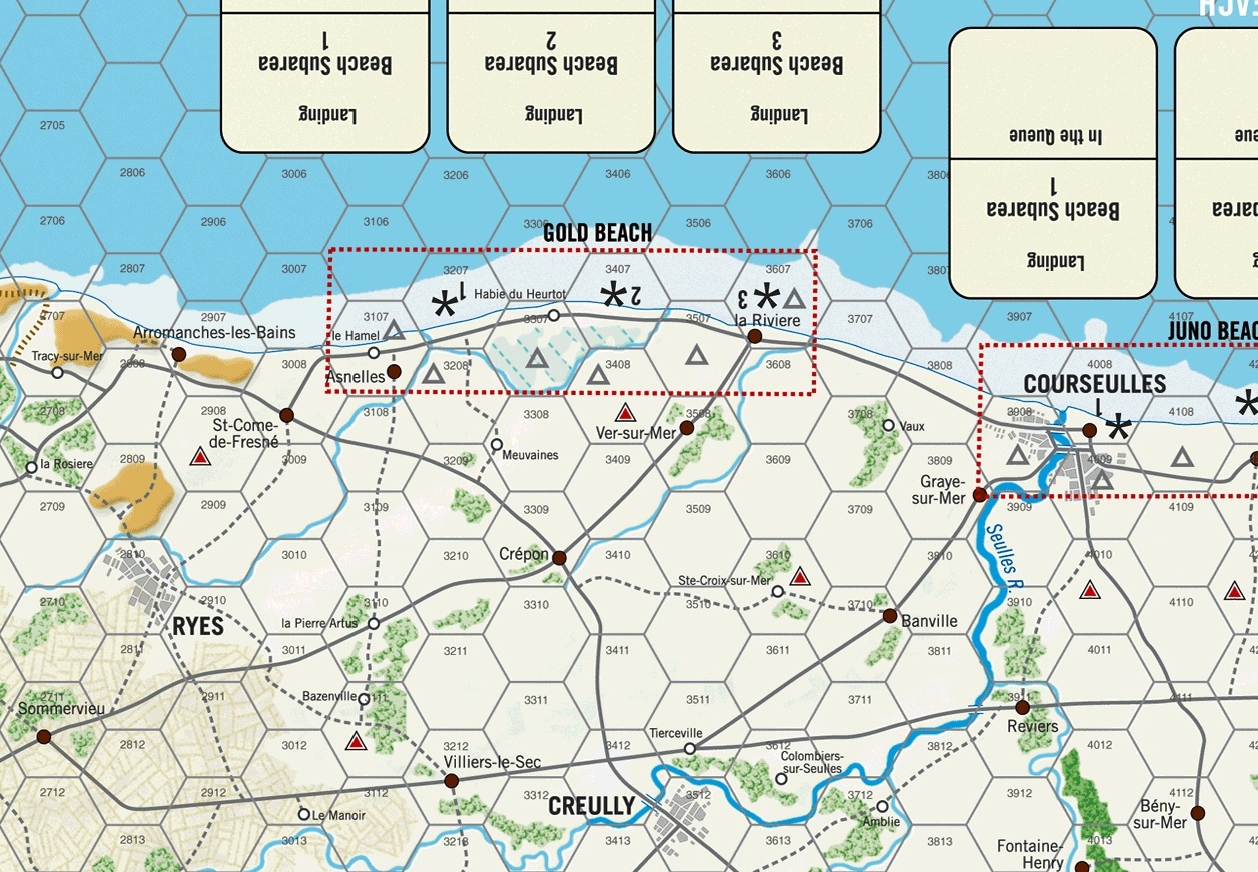
(The Greatest Day)
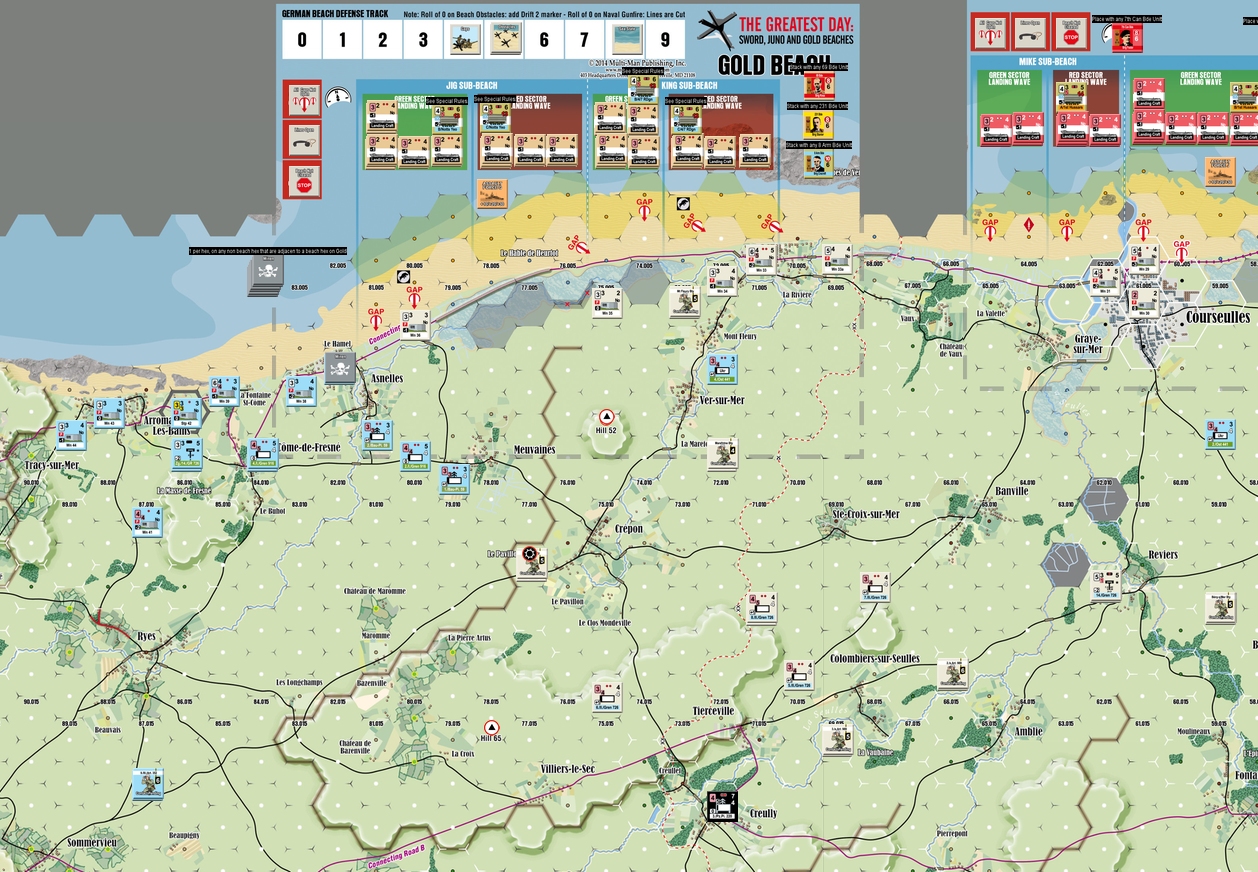
(The Longest Day)

To add some more detail and compensate the abstraction during the landings, Atlantic Wall uses some separate boards for the beaches, that are then funneled into the big map, for example (or here for the real thing):

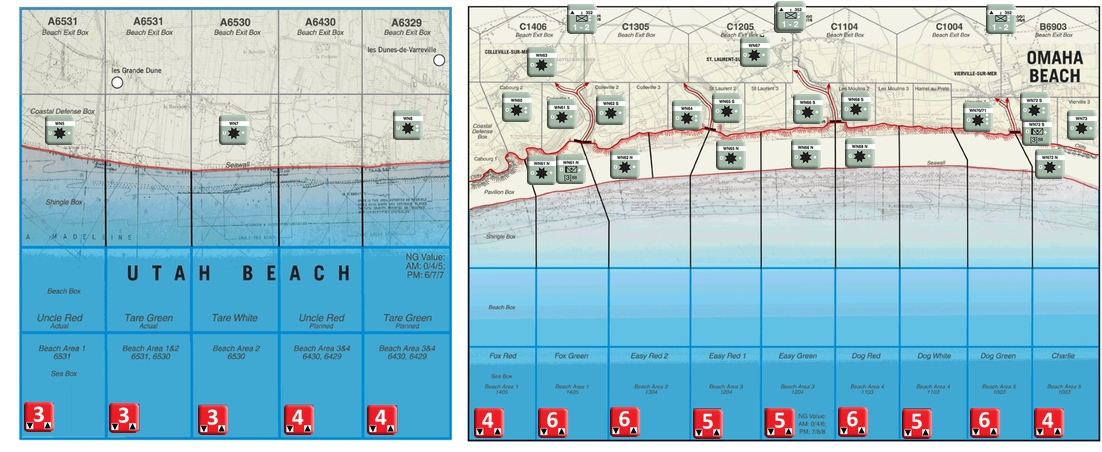
And here a wider comparison of The Greatest Day main area and the respective section in Atlantic Wall:
– Atlantic Wall
– The Greatest Day
I suppose it’s possible to go deeper. I’m pretty sure Advanced Squad Leader has some scenarios covering D-Day but that, too, will have to wait for another time.
